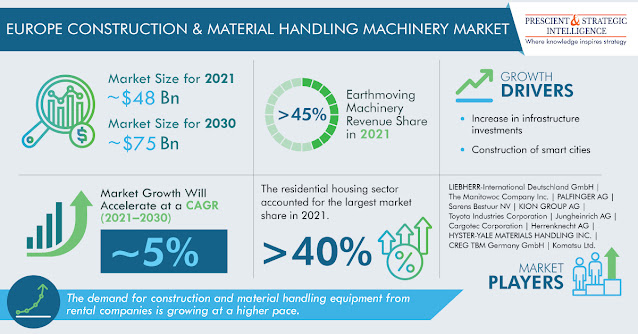Italy's material handling machinery market is on a trajectory of significant growth, projected to expand from USD 4.6 billion in 2024 to USD 6.35 billion by 2030, reflecting a compound annual growth rate (CAGR) of 5.5%. This surge is attributed to advancements in automation, a robust manufacturing sector, and the increasing demands of the e-commerce industry.
Automation and E-commerce Driving Demand
The integration of automation technologies is
revolutionizing Italy's industrial landscape. Manufacturers are increasingly
adopting automated guided vehicles (AGVs), conveyor systems, and smart
forklifts to enhance operational efficiency. This shift not only streamlines
logistics but also addresses labor shortages and reduces operational costs.
E-commerce, a significant contributor to this growth,
demands rapid and accurate order fulfillment. The need for advanced material
handling solutions to meet these demands has led to increased investments in
automated systems. Companies are focusing on green equipment that reduces
carbon footprints while enhancing energy efficiency, aligning with global
sustainability goals.
Diverse Applications Across Sectors
The market's expansion is not confined to a single sector. Transport,
energy, and water infrastructure projects are the largest end-users, reflecting
Italy's commitment to modernizing its public services. Residential housing is
also witnessing growth, with a CAGR of 3.3%, driven by urbanization and
government incentives promoting home building and renovations.
Contractors dominate the customer segment, accounting for
61.8% of the market in 2024. Their reliance on a diverse range of material
handling equipment underscores the importance of versatility and adaptability
in machinery offerings. Rental companies are emerging as a fast-growing
segment, with a CAGR of 6.4%, due to the flexibility and cost-effectiveness
they offer, especially to small and medium-sized enterprises.
Technological Innovations Fueling Growth
Product innovation remains a cornerstone of market growth. Companies
are introducing smart machines equipped with IoT capabilities for real-time
monitoring and analysis, enhancing process efficiency and reducing downtime. Automation
technologies, such as self-moving forklifts and robotic palletizers, are
addressing labor shortages and increasing operational throughput.
The shift towards electric propulsion is notable, with
electric material handling machinery projected to grow at a CAGR of 25.4%. This
trend is fueled by environmental concerns, regulatory pressures, and the
benefits of reduced noise pollution and lower maintenance requirements
associated with electric equipment.
Competitive Landscape and Future Outlook
Italy's material handling machinery market is characterized
by fragmentation, with numerous original equipment manufacturers (OEMs)
offering a wide array of products. Key players include LIEBHERR-International
Deutschland GmbH, Caterpillar Inc., AB Volvo, Sany Heavy Equipment
International Holdings Company Limited, and Komatsu Ltd. This competitive
environment fosters continuous innovation and strategic pricing, compelling
manufacturers to enhance their offerings to attract and retain customers.









